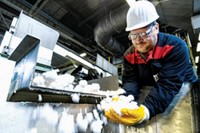Advertisement
Grab your lab coat. Let's get started
Welcome!
Welcome!
Create an account below to get 6 C&EN articles per month, receive newsletters and more - all free.
It seems this is your first time logging in online. Please enter the following information to continue.
As an ACS member you automatically get access to this site. All we need is few more details to create your reading experience.
Not you? Sign in with a different account.
Not you? Sign in with a different account.
ERROR 1
ERROR 1
ERROR 2
ERROR 2
ERROR 2
ERROR 2
ERROR 2
Password and Confirm password must match.
If you have an ACS member number, please enter it here so we can link this account to your membership. (optional)
ERROR 2
ACS values your privacy. By submitting your information, you are gaining access to C&EN and subscribing to our weekly newsletter. We use the information you provide to make your reading experience better, and we will never sell your data to third party members.
Business
AkzoNobel has new route to ethyleneamines
Dutch firm claims technology is a ‘game changer’
by Alex Scott
October 9, 2017
| A version of this story appeared in
Volume 95, Issue 40
AkzoNobel says it has developed a breakthrough process for making higher ethyleneamines and derivatives. The new process will reduce raw material consumption and substantially improve cost and environmental performance compared with existing processes, the firm says.
Ethyleneamines are intermediate chemicals for products such as epoxy curing agents, which are in demand for wind turbine fabrication. They are also additives for oil, road materials, and paper. The global ethyleneamines market is between 550,000 and 600,000 metric tons per year, according to IHS Markit.

The manufacture of ethyleneamines is currently dominated by two routes. One involves the reaction of monoethanolamine (MEA) and ammonia in the presence of a hydrogenation-dehydrogenation catalyst. The second involves reacting ethylene dichloride (EDC) with ammonia. AkzoNobel operates two ethyleneamines plants in Europe, each of which uses one of the processes.
But the MEA process is ineffective at producing high yields of important ethyleneamines featuring three or more ethylene units. The EDC process is expensive and involves undesirable chlorine chemistry.
AkzoNobel is keeping tight-lipped about the specifics of its new chemistry. But a company patent published in August 2017 outlines a process to make ethyleneamines “by reacting an ethanolamine functional compound with an amine functional compound in the presence of a carbon oxide delivering agent.”
The new process generates high yields of amines that contain at least three ethylene units, including diethylenetriamine and triethylenetetramine, the firm says. It claims that the new technology will markedly strengthen its product portfolio.
AkzoNobel is also confident that its breakthrough can unseat existing processes. “We strongly believe it has the potential to become a game changer in the industry,” says Joppe Smit, general manager of the firm’s ethyleneamines business. It plans to build a demonstration plant for the technology in 2018.




Join the conversation
Contact the reporter
Submit a Letter to the Editor for publication
Engage with us on Twitter